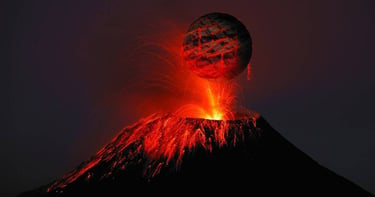11 Facts About Volcanoes
Explore 11 amazing facts about volcanoes, including the physics underlying these violent natural marvels and their spectacular outbursts.
FACTS ABOUT


Volcano Eruption (credit: pixabay)
You are not by yourself if you have ever seen videos of sparkling lava streaming down a slope and experienced an odd mixture of amazement and anxious anticipation. I recall attempting to provide clarification on volcanoes to a buddy who believed they were "basically just fire mountains." I looked at him with a mixture of astonishment and serious worry, similar to how you look at an individual who inserts metal in a microwave. We frequently underestimate how complicated, chaotic, and oddly lyrical volcanoes are. The manner in which they affect climate, reshape landscapes, and sometimes serve as a reminder of our own little size is what makes them so interesting. To help you understand, consider Earth as a boiling pot with surface-cracking hotspots. One of nature's most spectacular displays occurs when that pressure is released. The eleven volcanoes facts listed below demonstrate how remarkable these features truly are; each is discussed with uniqueness, straightforwardness, and practical usefulness.
Volcanoes Can Form Underwater: Plenty of volcanoes rise softly beneath the ocean, yet majority of individuals envision huge mountains. These undersea beasts create gigantic seamounts, some of which reach heights of thousands of meters. While we are on land reading through our smartphones, they are silently creating underwater landscapes.
Volcanoes Can Influence Climate: Ash and sulfur dioxide from a large eruption can go upwards into the atmosphere that sunlight finds it difficult to reach the surface. This can lower global temperatures in extreme circumstances. The idea that an eruption on one side of the planet could have an impact on weather conditions halfway across the world is unthinkable.
Volcanoes Can Be Found on Other Planets: Volcanoes are not unique to Earth. The most massive existing volcano in the solar system, Olympus Mons, is located on Mars and rises to a height of almost 13.6 miles. The size of what we are discussing is equivalent to piling almost three Mount Everests on top of one another. You would not even notice the hill if you were standing on it due to its immense size.
Volcanoes Can Be "Dormant" For Thousands of Years: Prior to erupting with great force, a volcano may lie dormant for thousands of years. For instance, Mount St. Helens was silent for more than 120 years prior to to its eruption in 1980. It is the geological counterpart of an individual who hardly speaks then all of a sudden yelling across the room.
Volcanoes Can Create New Land: Hawaii, Iceland, and plenty of other islands were formed by volcanic action. A little more land is added to the ocean with each eruption that releases fresh lava. It seems as though Earth is gradually creating new locations for us to discover, sometimes more quickly than locals can construct new pathways.
Volcanic Eruptions Can Trigger Earthquakes: The earth may tremble considerably because of the passage of magma beneath the surface. You have probably experienced little waves slipping back and forth if you have ever handled a dish of water too fast. Now intensify the effect millions of times by substituting molten rock for the water.
Volcanoes Erupt Lava Fountains: Molten lava is shot hundreds of meters into the air by certain volcanoes. Particularly captivating are Hawaii's lava fountains, which are both breathtaking and threatening. They resemble natural fireworks, but you would not desire to be anywhere close to them.
Volcanoes Can Form From Subduction Zones: When one tectonic plate gets shifted beneath another, volcanoes frequently occur. Magma is created as the sinking plate melts, rises, and ultimately causes an eruption. Consider tectonic plates as sluggish jigsaw pieces that are continuously disputing for territory.
Volcanoes Can Create "Lava Tubes": An unfilled tunnel may be left behind whenever a lava river cools on the outside but continues to flow inside. A number of these lava tubes last for thousands of years and are sufficiently massive to walk through. They offer an odd, somewhat unsettling window into previous volcanic events.
Volcanoes Are Not Always Explosive: Rather than erupting forcefully, certain volcanoes quietly drip lava. This kind of "effusive" behaviour is well-known in Iceland. Given that the lava flows gently enough to observe however quickly enough to completely consume a residence if the wind fails to be in your favour, locals occasionally become annoyed.
Volcanoes Can Eject Rocks The Size of Cars: Gigantic boulders can be released at amazing speeds by violent volcanic eruptions. These volcanic eruptions are unexpected and extremely hot. They are among the several factors that contribute to the admiration that volcanologists receive.
Summary: Erupting With Wonder
Volcanoes serve as a reminder that the planet is living beneath our feet. They transform continents, make new land, and sometimes have eruptions that impact the whole surroundings. Whether we are researching climatic conditions, making trip plans close to volcanic areas, or just attempting to refuel our hunger for knowledge, the more we know about them, the more adequately ready we are. You are not alone if you have experienced feeling overpowered while attempting to understand how they operate. Volcanoes function similar to moody artists, exceptional, unforeseen, and always fascinating, as even experienced geologists occasionally acknowledge. The above 11 facts provide a good foundation for understanding one of Earth's most extraordinary factors, whether you are a learner conducting coursework for school, an inquisitive adventurer, or an individual who simply enjoys spectacular natural events.
